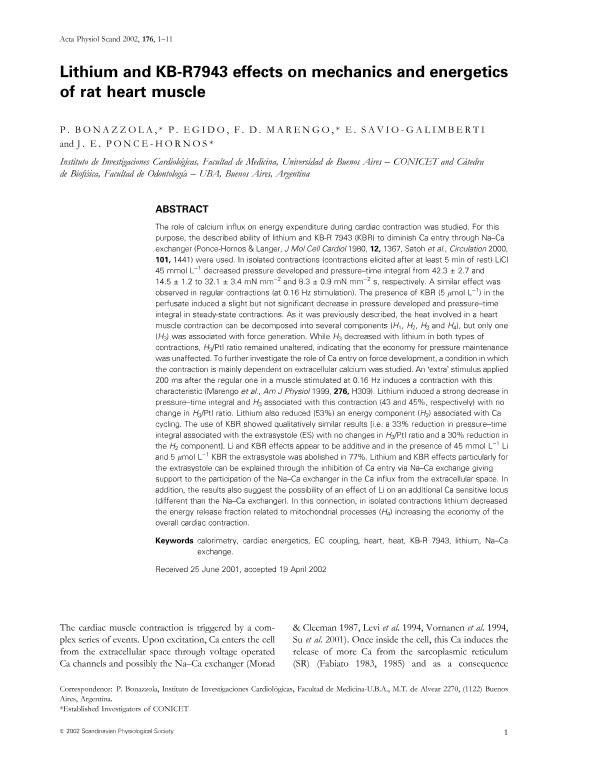Artículo
Lithium and KB-R7943 effects on mechanics and energetics of rat heart muscle
Bonazzola, Patricia ; Egido, P.; Marengo, Fernando Diego
; Egido, P.; Marengo, Fernando Diego ; Savio Galimberti, E.; Ponce Hornos, Jorge Emilio
; Savio Galimberti, E.; Ponce Hornos, Jorge Emilio
 ; Egido, P.; Marengo, Fernando Diego
; Egido, P.; Marengo, Fernando Diego ; Savio Galimberti, E.; Ponce Hornos, Jorge Emilio
; Savio Galimberti, E.; Ponce Hornos, Jorge Emilio
Fecha de publicación:
05/2002
Editorial:
Wiley
Revista:
Acta Physiologica Scandinavica
ISSN:
0001-6772
Idioma:
Inglés
Tipo de recurso:
Artículo publicado
Clasificación temática:
Resumen
The role of calcium influx on energy expenditure during cardiac contraction was studied. For this purpose; the described ability of lithium and KB-R 7943 (KBR) to diminish Ca entry through Na-Ca exchanger (Ponce-Hornos & Langer, J Mol Cell Cardiol 1980, 12, 1367, Satoh et al., Circulation 2000, 101, 1441) were used. In isolated contractions (contractions elicited after at least 5 min of rest) LiCl 45 mmol L -1 decreased pressure developed and pressure-time integral from 42.3 ± 2.7 and 14.5 ± 1.2 to 32.1 ± 3.4 mN mm -2 and 8.3 ± 0.9 mN mm -2 s, respectively. A similar effect was observed in regular contractions (at 0.16 Hz stimulation). The presence of KBR (5 μmol L -1) in the perfusate induced a slight but not significant decrease in pressure developed and pressure-time integral in steady-state contractions. As it was previously described, the heat involved in a heart muscle contraction can be decomposed into several components (H 1, H 2, H 3 and H 4), but only one (H 3) was associated with force generation. While H 3 decreased with lithium in both types of contractions, H 3/PtI ratio remained unaltered, indicating that the economy for pressure maintenance was unaffected. To further investigate the role of Ca entry on force development, a condition in which the contraction is mainly dependent on extracellular calcium was studied. An 'extra' stimulus applied 200 ms after the regular one in a muscle stimulated at 0.16 Hz induces a contraction with this characteristic (Marengo et al., Am J Physiol 1999, 276, H309). Lithium induced a strong decrease in pressure-time integral and H 3 associated with this contraction (43 and 45%, respectively) with no change in H 3/PtI ratio. Lithium also reduced (53%) an energy component (H 2) associated with Ca cycling. The use of KBR showed qualitatively similar results [i.e. a 33% reduction in pressure-time integral associated with the extrasystole (ES) with no changes in H 3/PtI ratio and a 30% reduction in) the H 2 component]. Li and KBR effects appear to be additive and in the presence of 45 mmol L -1 Li and 5 μmol L -1 KBR the extrasystole was abolished in 77%. Lithium and KBR effects particularly for the extrasystole can be explained through the inhibition of Ca entry via Na-Ca exchange giving support to the participation of the Na-Ca exchanger in the Ca influx from the extracellular space. In addition, the results also suggest the possibility of an effect of Li on an additional Ca sensitive locus (different than the Na-Ca exchanger). In this connection, in isolated contractions lithium decreased the energy release fraction related to mitochondrial processes (H 4) increasing the economy of the overall cardiac contraction.
Archivos asociados
Licencia
Identificadores
Colecciones
Articulos(IFIBYNE)
Articulos de INST.DE FISIOL., BIOL.MOLECULAR Y NEUROCIENCIAS
Articulos de INST.DE FISIOL., BIOL.MOLECULAR Y NEUROCIENCIAS
Articulos(ININCA)
Articulos de INST.DE INVEST.CARDIOLOGICAS (I)
Articulos de INST.DE INVEST.CARDIOLOGICAS (I)
Citación
Bonazzola, Patricia; Egido, P.; Marengo, Fernando Diego; Savio Galimberti, E.; Ponce Hornos, Jorge Emilio; Lithium and KB-R7943 effects on mechanics and energetics of rat heart muscle; Wiley; Acta Physiologica Scandinavica; 176; 1; 5-2002; 1-11
Compartir
Altmétricas



